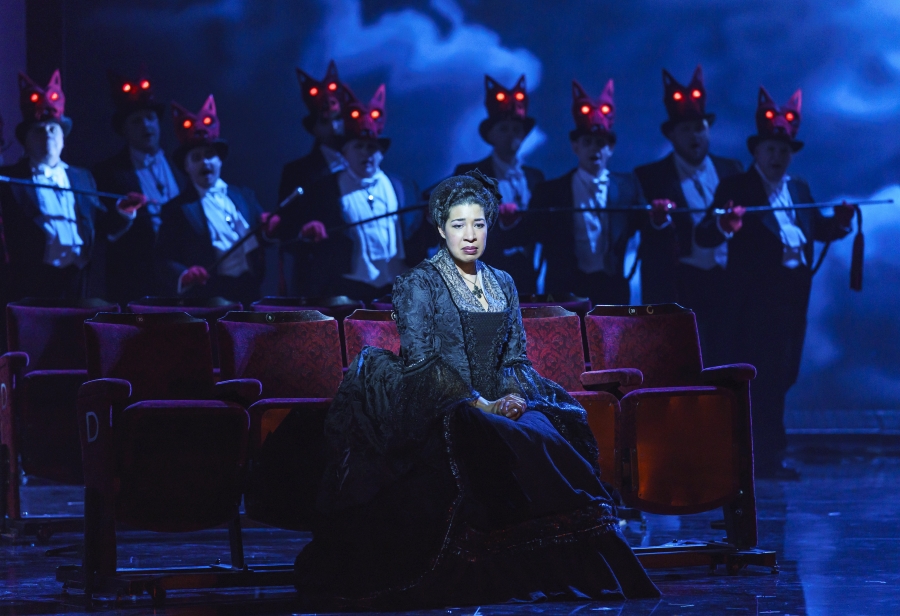WNO opens its Spring season with this interesting take on a work out of the Verdian repertoire which, while by no means obscure, does certainly not enjoy as intensive an attention as an Aida or a Traviata. In comparison with other works by Verdi, Un Ballo in Maschera is also musically less stiff and more experimental, and WNO’s approach appears to particularly relish this aspect, indulging in a less conventional mise-en-scène in terms of costumes, designs, and performances alike. It’s a strong, bold opening to the season, which leaves little middle grounds and is likely to elicit either extremely positive or strongly negative reactions in its audience, and certainly a high-impact take on a work whose musical quirks are contrasted by an extremely linear plot.
The work is also historically controversial; originally based off Eugène Scribe’s libretto for the 1833 opera Le Bal Masqué, concerning the assassination of Gustav III of Sweden, it was subjected to multiple rounds of censorship, forcing the relocation of the plot to Boston, the change of identity of all characters involved, and causing some degree of deliberate ambiguity surrounding the character of Oscar, which is taken by a soprano (here a vivacious, lively Julie Martin du Theil, perfectly in voice throughout) possibly as a covert nod to the Swedish king’s notorious homosexuality. The character is interesting in that Verdi did not typically like assigning male parts to female voices, and Martin du Theil does an excellent job in conveying a sense of convincing androgyny that well suits the ambiguous nature of the part. A further nod to the controversial history of the work is seen towards the end of the first act, as a number of Swedish flags are brought to the stage that would otherwise appear out-of-place with this take on the opera, which espouses the Bostonian setting throughout. While the nod is appreciated, it does appear rather jarring in that the Swedish background of the opera is never really referenced elsewhere; it is clever and witty, but it could have been better integrated.
Gwyn Hughes Jones gives a hearty and boisterous, if occasionally somewhat stiff, performance as Riccardo; he is at his best in the longer arias, which allow him to better express the full body of his voice. His final section in the scene of Riccardo’s death is probably his strongest, allowing him to indulge his softer, mellower tones, which are probably his greatest strength vocally. He has excellent stage chemistry with Mary Elizabeth Williams, who is charming, skittish, and powerfully tragic in turn as Amelia. Her performance is easily the strongest of the evening, with a peak in the third act, where she delivered the Morrò, ma prima in grazia aria with both grace and poignancy. She has an excellent grasp of the dualities of her character, and a great command of body language is matched by a fluid, confident and clean delivery. Roland Wood as Renato gets an excellent chance to explore the lower range of his voice and aptly handles the transition from poised and granitic to incensed and tormented that accompanies his character arc. The choral parts are also among the most effective, and add a touch of lightheartedness to the pivotal points of the plot.
Gwyn Hughes Jones, Roland Wood and Mary Elizabeth Williams
Mary Elizabeth Williams
WNO has been known in the past to make some bold choices in terms of stage setting and costume design, and this production of Un ballo in maschera is no exception. The cast exhibits almost all-black costumes, with the entire staging coded almost entirely in black and red; the result is half expressionist, half postmodern. While this matches the darker settings of this opera, with its undertones of sorcery and bloodthirsty revenge, the staging is most effective when it inclines to the minimalistic; the expressionist vibe comes across more powerfully and convincing when the job of conveying it is left to some austere building façades and red curtains, whereas some of the more elaborate scenes are at times at risk of appearing overcrowded. The titular masked ball is converted into a dance macabre, with the revellers attired as skeletons and death’s heads in pure day-of-the-dead style. It might be a somewhat heavy-handed metaphor, but the visual effect is startling.
It is certainly a brave and intriguing opening to the season, with WNO confirming itself as capable of continuously pushing the bar upwards for its productions.Un ballo in maschera makes many bets, and not all of them are entirely successful; but the result is stark and startling and different, and very much in tune with the spirit of Verdi’s work.


